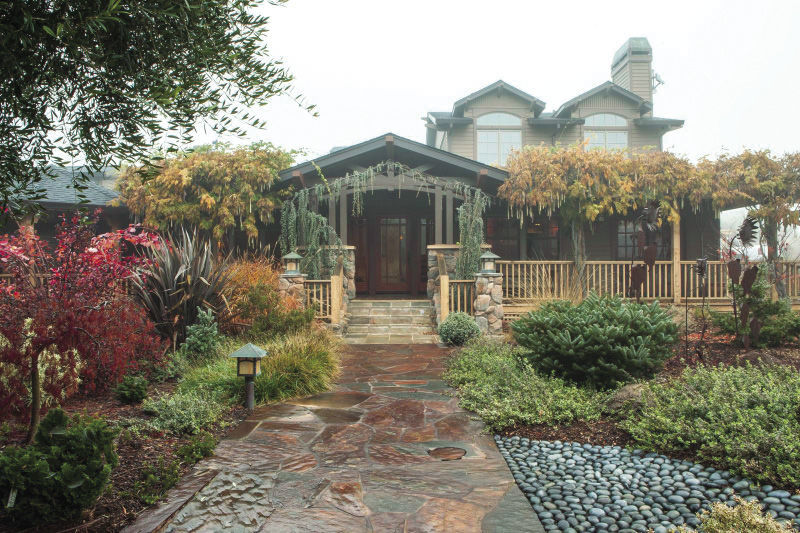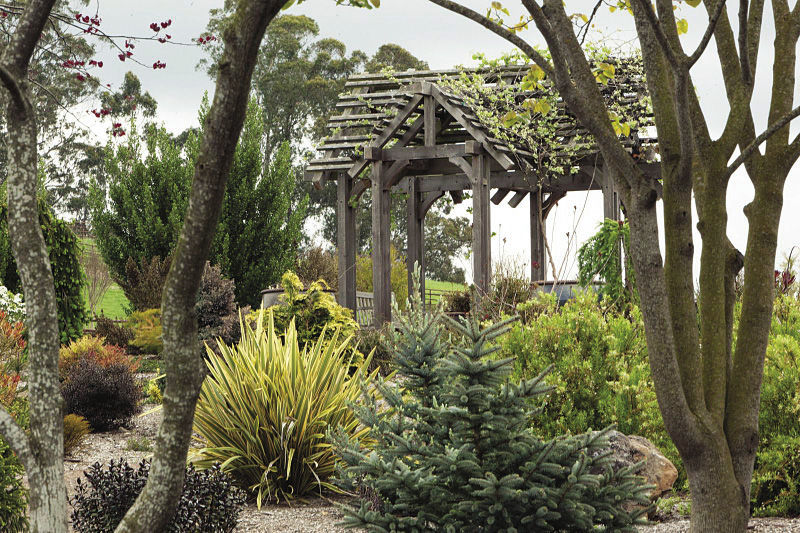
I have a large garden on a horse ranch in Petaluma, California, and when I arrived here 16 years ago, the landscape consisted of acres of reclaimed pasture festooned with a few ancient oaks and a handful of adolescent redwoods. I couldn’t bear the bareness, and attacked my garden-making project with much verve but without much forethought. I didn’t have a budget to buy all the plants I needed, so I scrounged plants wherever I could, haunting nursery sales and end-of-season closeouts. I paid little attention to care requirements. If it was a plant that I liked and would fit into what I somewhat grandiosely thought of as “my design,” I bought it and found a spot for it.
It took me a while, but I ended up with a pretty nice garden. It was sumptuous and eclectic, reflecting my tastes to a reasonable degree as well as representing the overstock of Sonoma County nurseries. The vast majority of the plants were flowering perennials, capable of vivid seasonal displays. Caring for such a large, maintenance-intensive garden, however, started to take a toll on my body. I also began to resent the fact that all that work resulted in a garden that only looked its best in late spring and summer.
Reliable structure replaces high-maintenance flowers
One year, winter’s arrival coincided with that of a new puppy, which had to be taken out in the middle of the night. As I marked time in the front garden, waiting for her to take care of business, I realized that the garden looked completely different in the dark, lit only by the walkway lights. It was easier to see the garden’s overall structure than to see the individual plants. The ornamental grasses and perennials were dormant and shapeless, with no color or form and little texture. Daylight found me pulling out a plant here, a clump there. After a few weeks, I had reduced the front garden to a few plants that I loved or that served as anchors. I then spent many mid-nights looking at the nearly empty space, pondering where I needed to add structure and definition to make the garden look balanced in the daytime. I also decided that I wanted to change the flower-intensive style, with its reliance on plants that required regular cutting back and dividing. I began to think in terms of form and foliage rather than just flowers, and this meant a much greater use of trees, shrubs, and evergreens. Several books on conifers and foliage shrubs helped me focus, and I discovered a remarkable variety of leaf colors, textures, and shapes. The conifers had needles that ranged from blue to lime and from gold to every shade of green imaginable. Some were spiky, and some were soft and wispy; some were weepers, and some were erect and proud. Broad-leaved evergreens, often with glossy foliage, provided richness and depth. Deciduous trees and shrubs, if chosen wisely, could add interesting bark and sculptural accents, even when not in leaf.

Using the plant lists that I had developed from my reading, I slowly started adding plants back into the garden, replacing those maintenance-intensive perennials with plants with exceptional foliage and form. True, the garden lost most of its flowers, but it gained the bright red stems of mountain pepper (Drimys spp. and cvs., USDA Hardiness Zones 8–11); the golden yellow needles of false cypress (Chamaecyparis spp. and cvs., Zones 4–9); the rigid, dark spikiness of New Zealand flax (Phormium spp. and cvs., Zones 8–11); and the crisp green-and-white foliage of wintercreeper (Euonymus fortunei* cvs., Zones 5–9). What’s more, these attributes are on show all year long. I still use perennials but in the same way that I use jewelry or accessories to accent an outfit: The woody plants are the garden’s clothing, the flowers the jewels. And my garden no longer looks dormant in the depths of winter or parched in the heat of summer.
A well-balanced garden requires ample patience
Many of the plants in my new design make strong structural statements, providing a foundation and frame that the softer perennials did not. I taught myself not to be afraid of open space between the plants. Where the more informal perennial garden had featured a riot of plants running together, this new approach could afford to highlight individual shapes. It was challenging to plant such a strong mixture of shapes, colors, and textures in a pleasing way. I learned to place the plants in their pots where I thought they belonged, and leave them there for a few days while I took in their arrangement and compatibility. Rarely did I plant them where I had initially placed them.

While this approach to garden design was more time-consuming and expensive than my first one was, several factors mitigated the investment of time and money. First, the time invested was exactly that: an investment. The likelihood was that, if I got it right, I wouldn’t be ripping out large sections of the new garden, so time spent now was time saved later. More important, my new design requires a fraction of the annual maintenance that my old one did. While many of the perennials were drought tolerant, the shrubs are mostly deeper rooted; in addition, the conifers are largely indigenous to areas with climatic extremes, and many withstand drought conditions reasonably well. My Petaluma soil is heavy and I mulch abundantly, so my water use has not increased. The advantages are not just practical. I love the way each plant’s structure is displayed to its best advantage, and I love the striking combinations of maroon and blue-green or lime and brown foliage. I also love the fact that, now, the front garden is attractive year-round. Compared to the flowering perennials, these plants generally grow more slowly; thus, there will be minimal need to alter the design as plants outgrow their locations. In my choices of deciduous shrubs and trees, I favored those with spectacular fall color, such as viburnums (Viburnum spp. and cvs., Zones 3–9), barberries (Berberis spp. and cvs., Zones 3–9), Japanese maples (Acer palmatum cvs., Zones 5–8), and smoke bushes (Cotinus coggygria cvs., Zones 5–9), so November in my garden is now more dramatic than June.

My garden is not for everyone: It’s not the most spectacular garden in spring and summer, and it’s definitely not the most floriferous. But it’s packed year-round with beautiful blues, golds, limes, purples, silvers, pinks, browns, and creams. And remember, that’s the foliage that I’m describing.
Four Seasons of Spectacular Color
When most of us think about foliage, we think of its most obvious and desirable uses—as a mass to provide a screen or hedge, for example. We also tend to think of foliage in autumn, when we see the deciduous trees begin to change color. Foliage, however, can provide a stunning display in any season, and some foliage can give even the most spectacular flowers a run for their money. The following are my favorite stars for each season.
Spring
 |
 |
| Nothing is lovelier in March than the new growth on ‘Goldflame’ Japanese spirea (Spiraea japonica ‘Goldflame’, Zones 4–9). The leaves emerge the most delicious butterscotch color, with apricot and deep rose highlights. | Orange Rocket™ Japanese barberry (Berberis thunbergii Orange Rocket™, Zones 4–9) puts on a good show for the entire growing season, but in spring, the new leaves are a brilliant paprika color. |
Summer
Fall
 |
 |
| ‘Grace’ smoke bush (Cotinus ‘Grace’, Zones 5–8) is often selected for its flowers, and it has deep plum–purple leaves in spring and summer that turn a fiery red in fall. The foliage is more exciting than the flowers, and it lasts longer. | Thunberg spirea (Spiraea thunbergii and cvs., such as ‘Ogon’, pictured, and ‘Mt. Fuji’, Zones 5–8) is covered with a veil of lovely white flowers in spring. It reliably holds its own all summer, with lively foliage, ranging from chartreuse to lime, depending on the cultivar. In fall, it sets the garden ablaze with vivid hues of orange and red. |
Winter
 |
 |
| Silver hedgehog holly (Ilex aquifolium ‘Ferox Argentea’, Zones 7–9) is a true garden workhorse, with purple young shoots in spring, waxy cream-banded leaves all year, and showy berries on female plants in autumn. But it is in winter that I most appreciate its glossy variegated leaves. | Coral bark maple (Acer palmatum ‘Sango Kaku’, Zones 5–8) is another that lasts through multiple seasons, with chartreuse new growth in spring and lush limey foliage all summer. In winter, it lives up to its name with coral branches that light up the bleakest days. |
Sara Malone gardens in Petaluma, California.
Photos: Janice LeCocq; courtesy of Missouri Botanical Garden PlantFinder; Steve Aitken; courtesy of Richie Steffen/Great Plant Picks; courtesy of Monrovia; Michelle Gervais



















Comments
Log in or create an account to post a comment.
Sign up Log in